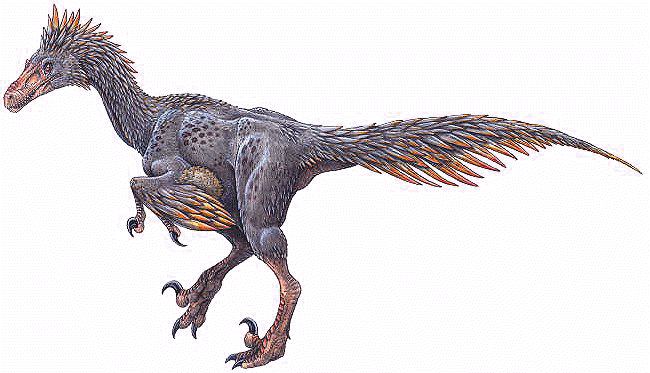|
Unenlagia is the most bird-like dinosaur found so far - it even
had arms that were designed so they could flap like a bird's wings.
However, this dinosaur was much too large to fly, but it clearly shows
how some dinosaurs were evolving to look and act like modern birds.
Some scientists think that Unenlagia is actually a young
Megaraptor, as the fossils were found in the same area. It is from the same general family that also includes
many of the dinosaurs that exhibited bird-like traits, including those
falling into the popular raptor category. It had a very pronounced
backward-pointing pubis, and it appears as though its shoulder was
designed to allow for flapping movements.
Unenlagia had a shoulder structure that allowed its short arms to move
forwards, backwards, inwards (for grasping prey), and up and down (for
a flapping motion). This flapping motion was not used for flying,
because its wing-like arms were too short to support the heavy
dinosaur. Perhaps these proto-wings were used for balancing, turning,
and a bit of lift during high-speed running. Although there is no
fossil evidence of feathers from Unenlagia, it may well have had them,
further adding lift to each upstroke of the proto-wings. It could
grasp prey with its clawed, short, wing-like forearms. This new fossil
helps show how dinosaur forearms evolved into the wings of modern-day
birds.
Unenlagia shoulder and arm design provide evidence relating to the
origins of flight. Paleontologists have debated about the origins of
flight. Did animals first leap from trees and glide, or flap and rise
from the ground? Unenlagia's bone structure supports the latter
theory, in which animals start from the ground up. On the other hand
(or proto-wing), Unenlagia might have evolved, like the ostrich, from
an earlier flying dinosaur; after all, birds had existed for over 60
million years already when Unenlagia lived.
Twenty fossilized bones from Unenlagia were unearthed in an ancient
river bed in the Patagonia region of Argentina (southern Argentina) by
Fernando Novas, of the Museum of Natural History in Buenos Aires.
Novas named the fossil Unenlagia comahuensis, meaning "half bird from
northwest Patagonia," in a combination of Latin and the language of
the local Mapuche Indians. Novas' discovery is described in the May
22, 1997, issue of Nature.
Were these animals basal birds? No, for they lived at a time when
small, highly aerodynamic birds had been in existence for several tens
of millions of years. But they probably resembled the true basal
birds, which may have been present during middle Jurassic time, 80
million years before Unenlagia was alive.
|
![]()
